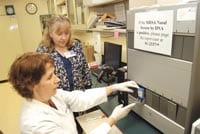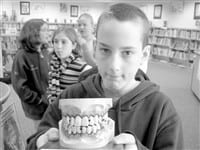Baystate Winning Battle Against Ventilator-associated Pneumonia
SPRINGFIELD — The prevention of hospital-acquired infections is a top priority of hospitals today as new practices and products are introduced into the care continuum to help minimize a patient’s exposure from the environment, as well as from equipment used in a variety of medical procedures.
Baystate Medical Center is actively involved in the prevention of all health care-associated infections, where on one floor — the Respiratory Intermediate Care Program located on Springfield 1 — staff have made a major difference in the prevention of ventilator-associated pneumonia (VAP), the second-most-common hospital-associated infection nationwide.
As a result of a team effort involving registered nurses, patient-care technicians, respiratory therapists, respiratory physicians, and infection-control practitioners, Baystate Medical Center’s Respiratory Intermediate Care Program has not had any cases of ventilator-associated pneumonia for three consecutive years.
“Achieving three years of preventing a single incidence of ventilator-associated pneumonia on our unit is a stellar accomplishment by staff on behalf of their patients, and is a reflection of their dedication and importance to them that their patients have positive outcomes,” said Cara Chandler, a clinical nurse educator from the Respiratory Intermediate Care Program.
“This is especially significant on a unit such as ours, where patients are on ventilators for long periods of time and are among the most susceptible to ventilator-associated pneumonia,” she added.
Ventilator-associated pneumonia is a lung infection most often affecting critically ill patients who require mechanical ventilation to help them breathe. A ventilator supports the patient’s breathing by delivering oxygen through a tube placed in the patient’s lungs.
According to the Institute for Healthcare Improvement, the mortality rate surrounding VAP, which afflicts those so weakened by illness or trauma that they need mechanical help to breathe, approaches 50{06cf2b9696b159f874511d23dbc893eb1ac83014175ed30550cfff22781411e5}. When the ventilator tube becomes contaminated, it can act as a pathway for bacteria or secretions to enter the respiratory tract, contributing to the contraction of ventilator-associated pneumonia.
According to Mary Ellen Scales, chief infection control officer at Baystate Medical Center, the hospital is committed to preventing VAP by ensuring that all patients on ventilators, both adults and children, are cared for using all evidence-based recommendations that have been shown nationally to reduce the risk of developing VAP.
Clinical evidence in hospitals around the country demonstrates that VAP risk is reduced by performing the following:
- Elevate the head of the bed by 30 degrees or better for adults and most pediatric patients, and 15-20 degrees for NICU babies;
- Evaluate daily if the patient needs to continue using the ventilator;
- Provide oral care every four hours; and
- Clean and sanitize hands.
Known as the ’ventilator care bundle,’ these national recommendations were implemented at all Baystate Health facilities under the direction of the Baystate Health VAP Prevention Collaborative in 2005.
“How many times have you heard a doctor or nurse say the best defense against germs, especially during the flu season, is to wash your hands? That is also the golden rule for doctors and other caregivers at all times when treating their patients, whether on a ventilator or not,” said Dr. John Landis, chief of Pulmonary Services at Baystate Medical Center, who sees many patients in the hospital’s Respiratory Intermediate Care Program.
“Equally important is the practice gaining national attention, for caregivers to remember to clean their stethoscopes with an alcohol swab after each use,” he added.




Comments are closed.